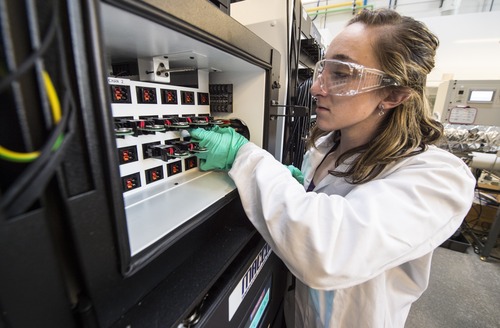Contaminant Identification Refines Recycling for Lithium-Ion Batteries
New Approach Aims To Improve Purity of Recycled Battery Materials

Researcher Kae Fink leads direct recycling technology development for lithium-ion
batteries at NREL. Photo by Dennis Schroeder, NREL
As the primary choice for high-powered personal electronics, electric vehicles, and grid-scale storage solutions, lithium-ion (Li-ion) batteries continue to dominate the marketplace. To meet clean energy goals of the future, researchers must develop safe and sustainable recycling processes for these batteries.
According to research from the Rochester Institute of Technology, an estimated 2.9 million Li-ion battery packs for electric vehicles alone will reach the end of their usefulness and no longer operate at peak capacity—termed “end of life”—by the year 2040. The National Renewable Energy Laboratory (NREL) is in a race against time to optimize recycling processes to maintain Li-ion supply chain stability and mitigate environmental hazards associated with the disposal of these batteries by improving the integrity of recycled materials.
Building a Sustainable Recycling Industry
To improve the ease and recyclability of Li-ion batteries, NREL is partnering with Argonne National Laboratory (ANL), Oak Ridge National Laboratory, and several universities as part of the U.S. Department of Energy’s ReCell Center. NREL contributes to cathode relithiation technologies, binder removal and recovery, black mass purification, supply chain analysis, and thermal analysis techniques within this collaboration. In support of this research, NREL and ANL recently published a study (subscription required) in the Journal of Power Sources demonstrating a new approach to identify metallic contaminants and impurities that impede existing recycling methods.
Circular Economy for Energy Materials
A circular economy for energy materials reduces waste and preserves resources by designing materials and products with reuse, recycling, and upcycling in mind from the start.
“Our battery recycling research focuses on direct recycling in order to reuse value-added products,” said Matt Keyser, senior energy storage engineer. “As an example, we relithiate and upcycle aged cathode materials for use in future batteries, but lithium battery designs are not monolithic, and there is a lot of work that still needs to be done.”
Direct recycling first involves shredding the battery to separate battery components without breaking down the chemical structure of the active materials. The resulting material—often called black mass—is ideal for recovery, regeneration, and reuse in battery designs. However, the shredding process may introduce metallic impurities into the recycled electrodes. The resulting contaminants pose a challenge for recyclers, inhibiting the performance of the recycled batteries.
An Integrated Approach to Contaminant Detection
To pinpoint these impurities, NREL and ANL combined electrochemical analysis with isothermal microcalorimetry to identify characteristic "fingerprints" for each metallic contaminant, including iron, aluminum, copper, silicon, and magnesium. This synergistic approach allows researchers to confirm the presence of contaminants and assess the impact of each metallic impurity on the overall performance of the recycled electrodes.
“This novel approach can detect unique signals for each of these contaminants,” said NREL energy storage researcher Kae Fink, who leads the Li-ion direct recycling technology development effort. “As a result, researchers can distinguish between problematic elements, such as aluminum or copper, and develop specific methods to meet purity standards for recycled battery materials.”
These findings unlock the potential to optimize direct recycling methods by highlighting which contaminants are most problematic in recycled materials and informing strategies for remediation and repurification to remove impurities. In addition, this analysis method is applicable beyond a laboratory environment, informing the development of industry-wide quality control metrics for recycled materials and leading to increased confidence in upcycled Li-ion batteries.
Learn more about NREL’s energy storage and transportation research.

